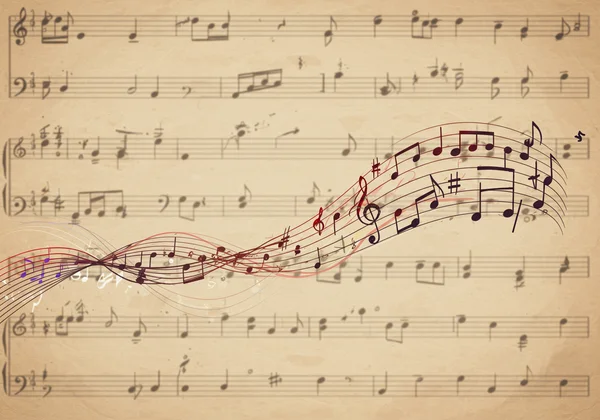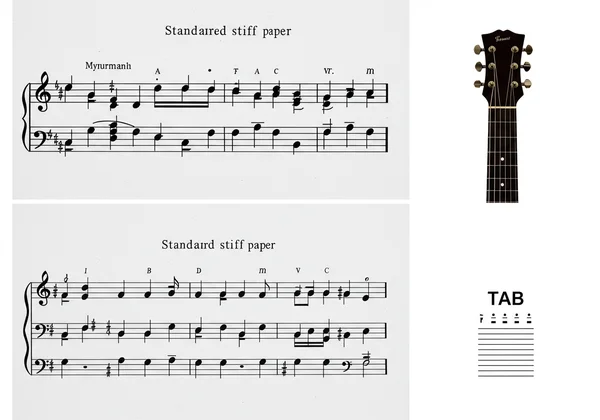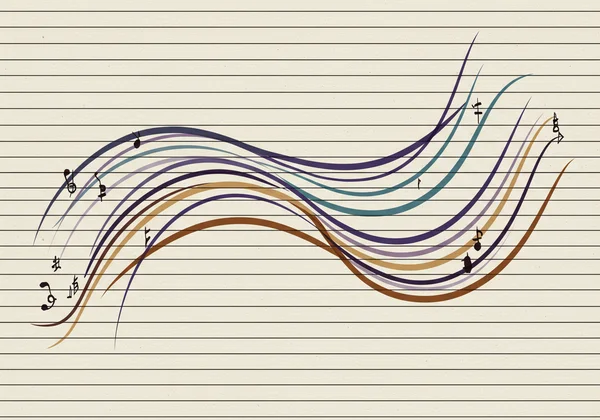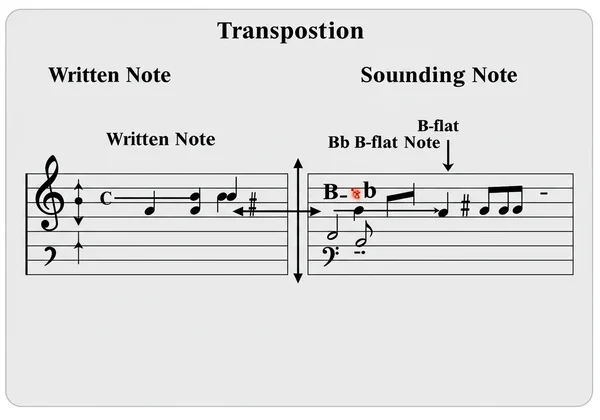Music Arranging Basics: Writing for Multiple Instruments on Printable Staff Paper
Have you ever listened to a simple melody and imagined it swelling into a rich tapestry of sound, played by a full ensemble? That transformation from a single line of music into a multi-layered masterpiece is the art of arranging. It's a skill that can seem daunting, but with a solid grasp of the fundamentals, you can unlock a new world of musical creativity. But what is the first step in arranging music? It begins with a clear vision and the right tools, and the most fundamental tool of all is the paper you write on.
This guide will walk you through the essential music arranging basics, from choosing the right instruments to preparing a clean, professional score. We'll show you how having access to free, high-quality, and customizable staff paper is not just a convenience—it's the foundation of your creative process. With the right customizable templates, you can focus on what truly matters: bringing your musical ideas to life.

Music Arranging Basics: Starting Your Ensemble Score
Before a single note is written, a successful arrangement starts with a clear plan and the proper setup. This foundational stage involves understanding why you are arranging the piece and ensuring you have the correct format for each instrument's part. Getting this right from the beginning saves countless hours of revision later on.
Understanding the Purpose of Arranging Music
At its core, music arranging is the art of re-imagining a piece of music for a different combination of instruments than the original. It’s more than just transcribing notes; it’s about adapting the melody, harmony, and rhythm to suit the unique voices and characteristics of a new ensemble. Whether you're arranging a pop song for a string quartet or a folk tune for a jazz combo, the goal is to preserve the essence of the original while creating something fresh and compelling. This process is a crucial part of composition and requires a deep understanding of basic music theory to translate ideas effectively between different instrumental contexts.
Choosing the Right Staff Paper for Each Instrument
You wouldn't build a house without the right blueprints, and you shouldn’t write an arrangement without the right staff paper. Each instrument has unique notational needs. A pianist requires a grand staff to accommodate both hands, a guitarist often needs a combination of standard notation and tablature (TAB), and a vocalist just needs a single-line stave. Trying to force everything onto generic staff paper leads to messy, unreadable scores.
This is where a versatile tool becomes indispensable. Instead of buying dozens of different manuscript books, you can instantly generate the exact format you need. Do you need a grand staff with 10 staves per page? Or perhaps guitar staff paper with integrated TAB? Having access to a library of professional templates ensures every part is clear, organized, and perfectly suited for the musician who will play it.

Writing for Multiple Instruments: Voice Leading & Texture
Once your score is set up, the creative work of writing for multiple instruments begins. This involves more than just assigning the melody to one instrument and chords to another. A great arrangement weaves individual parts together into a cohesive and interesting texture, using the principles of voice leading and harmony to create a satisfying whole.
Knowing Your Instruments: Ranges and Timbres
The most critical skill in arranging is understanding the instruments you're writing for. Each instrument has a specific range—the set of notes it can comfortably play—and a unique timbre, or tonal color. Writing a part that is too high or low for an instrument will result in a poor performance or make it unplayable. Furthermore, knowing an instrument's timbre helps you blend sounds effectively. For example, the warm, mellow tone of a French horn blends beautifully with a cello, while the bright, piercing sound of a trumpet can cut through the entire ensemble. Before you write, take time to study the instrument ranges and characteristics. Keeping separate sheets of blank sheet music for each instrument can help you focus on its specific capabilities as you compose.
Crafting Cohesion: Basics of Voice Leading and Harmony
Voice leading is the art of moving individual melodic lines smoothly from one chord to the next. Good voice leading creates a sense of logical flow and makes the music more pleasing to the ear. Even if the underlying harmony is simple, strong voice leading can make an arrangement sound sophisticated and professional. Similarly, understanding harmony is essential for creating emotional depth. Will you use simple, open chords for a folk-like feel, or complex, dense harmonies for a dramatic, cinematic effect?
Sketching out your ideas is crucial. Use printable staff paper to experiment with different harmonic progressions and melodic lines. How does the bass line move against the melody? Do the inner voices (viola and second violin, for example) have interesting parts to play, or are they just filling in chords? A well-crafted arrangement gives every instrument a meaningful role to play. You can start building your harmonic ideas on some fresh manuscript paper today.

Small Ensemble Arranging: Preparing Your Score on Staff Paper
As you approach the final stages of your arrangement, the focus shifts to the technical details of score preparation. For a small ensemble arranging project, this means dealing with transposing instruments and ensuring the final score is impeccably clear and readable for the performers.
Demystifying Transposing Instruments: A Practical Approach
Many common instruments, especially in the brass and woodwind families, are "transposing instruments." This means the note they read and play sounds as a different pitch. For example, when a B-flat trumpet player reads a C, the note that actually sounds is a B-flat. A French horn in F reads a C, and we hear an F. This can be confusing, but the principle is straightforward: you must write their parts in a different key so that they sound correct when played with "concert pitch" instruments like the piano or flute. Transposition is a non-negotiable step for creating a functional score. To manage this, you'll need to create a separate, transposed part for each of these instruments. Using an online tool to prepare your parts ensures you can create as many unique sheets as you need without any cost.

Laying Out Your Final Score: Clarity and Readability
The final step is preparing a clean, legible score and individual parts. The ultimate goal of your score is clear communication with the performers. This means using consistent spacing, clear dynamics and articulation markings, and logical page turns. A cluttered, handwritten score can lead to mistakes and frustration in rehearsal. The quality of your underlying staff notation paper makes a significant difference. Starting with a high-resolution, professionally formatted PDF ensures that your final printed score looks sharp and is easy to read. A clear layout not only demonstrates professionalism but also shows respect for the musicians' time and effort, making them more likely to deliver a great performance of your work.
Start Arranging Today: Your Creative Journey Awaits!
Arranging music for multiple instruments is a rewarding journey that blends technical knowledge with artistic expression. By understanding the purpose of arranging, knowing your instruments, applying the principles of harmony and voice leading, and carefully preparing your score, you can transform simple ideas into compelling musical experiences.
Don't let the search for the perfect page stifle your inspiration. The days of sketching staves or running out of manuscript books are behind you. Your creative journey in arranging music is ready to begin, and it starts with having the right tools. Explore our site now to download the perfect free staff paper for your next project and watch your musical vision take shape!
Frequently Asked Questions About Music Arranging and Staff Paper
Where can I get free staff paper for my arrangements?
You can get high-quality, completely free staff paper directly from our site. Unlike generic templates, our tool allows you to customize the paper for your specific ensemble, whether you need a grand staff for piano, a percussion stave for drums, or a standard five-line stave for a vocalist. You can get free staff paper instantly without any registration.
How can I make my own staff paper for specific instrument parts?
Making your own staff paper is simple with an online generator. On our site, you can customize your paper by choosing the instrument type (like piano, guitar, or choir), selecting the clef (treble, bass, alto, or tenor), adjusting the number of staves per page, and setting the paper size (A4 or Letter). This ensures each part is perfectly formatted for the intended musician.
How many lines are on standard staff paper for different instruments?
Standard staff paper for most instruments like the flute, violin, or voice uses a five-line stave. However, other instruments have different needs. A piano requires a grand staff, which combines two five-line staves (for a total of 10 lines, connected by a brace). Guitar music often uses a standard five-line stave paired with a six-line tablature (TAB) staff. You can explore templates for all these formats and more on our site.